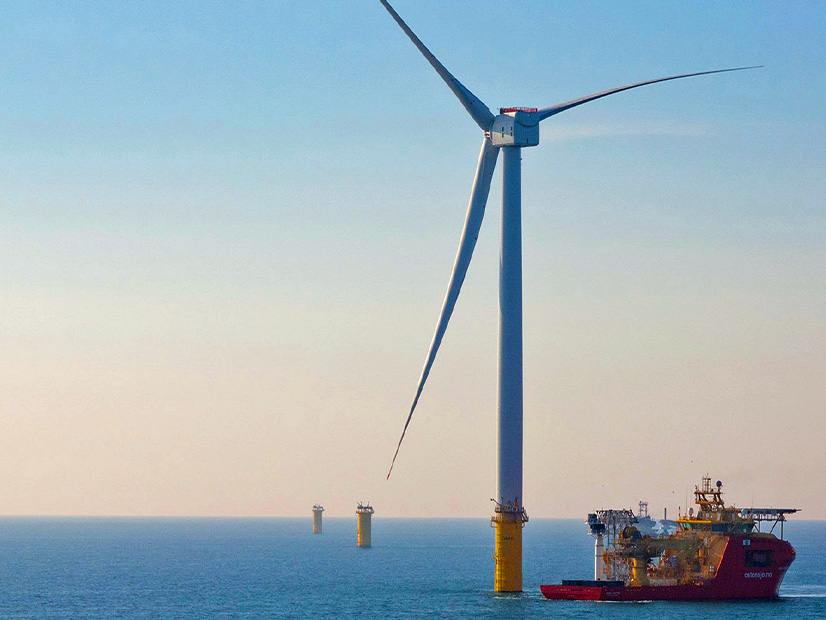
A new report indicates Western wind turbine manufacturers saw demand for their products ease in 2023 amid a stalled market, while Chinese companies saw surging demand due to their country’s rapid buildout of wind energy generation.
The May 1 report by Wood Mackenzie indicates that for the first time, Chinese manufacturers accounted for four of the top five companies globally by 2023 sales capacity: Goldwind (16.3 GW), Envision (14.1 GW), Windey (10.1 GW) and Mingyang (9.9 GW).
Denmark’s Vestas was the only Western manufacturer in the top five, coming in at No. 3 with 11.5 GW, the data and analytics company said in its report.
The four Chinese manufacturers achieved their sales volume almost entirely in China, but competition in that country was intense enough that turbine prices dropped 16% for onshore models and 9% for offshore.
Wood Mackenzie said Western manufacturers accounted for 93% of wind turbine sales outside of China. The top five in this category were Vestas (28.5% market share), Siemens Gamesa (24.3%), GE (18.1%), Nordex (15.9%) and Enercon (6.1%).
And 2023 was the sixth year in the top position for Vesta, Wood Mackenzie said. It noted that GE’s ranking was due in part to the strength of its U.S. onshore market.
GE Vernova, the recent spinoff of the conglomerate’s power business, released its first-quarter financial results April 25.
During a conference call with financial analysts that morning, CEO Scott Strazik said the onshore segment of the Wind business recorded a positive EBITDA for the third straight quarter despite a lower volume of orders. The offshore segment saw improvement but still recorded a loss.
The company expects onshore revenue to be substantially higher in the second half of 2024 than in the first, he said, but cannot say exactly when U.S. orders will pick up, due to trouble customers are having with permitting.
“Importantly, we see North American developers rebuilding their project pipeline as evidenced by the growing onshore interconnection queues,” CFO Ken Parks said.
Strazik said the company would work through its offshore wind segment backlog and remain “highly selective” on new orders.
GE Vernova’s offshore segment was in the news April 19, when New York state canceled its entire third offshore wind solicitation because GE Vernova had opted not to bring to market an 18-MW variant of its Haliade-X turbine the company previously said it would develop. (See NY Offshore Wind Plans Implode Again.)
Provisional contracts for three offshore wind farms totaling 4 GW of capacity had been designed around the 18-MW platform, and the prospect of using lesser-capacity turbines rendered the provisional contracts unworkable, the state said.
A week later, on the conference call, Strazik did not directly address that issue except to say the company believes offshore wind will play an important role in the energy transition and appreciated the partnership of New York as it pursues its ambitious offshore wind goals amid repeated setbacks.
However, he did speak about the U.S. offshore wind industry generally, and made no mention of a future 18-MW Haliade-X:
“With the phase that offshore wind has been in generally over the last few years, it’s been hard to get projects to a point that they’re ready to thrive,” he said.
“But through our iteration with our customers and where we’re going, I want to tell you, we’re excited about our future product here, a 15.5-MW product that has an ability to have a power boost up to 16.5 MW. We’re working hard to have that prototype running by the end of 2025. And when we look at where we are with our Haliade-X product today, the 14-megawatt product, by the time you get into 2026, we’re going to have somewhere in the neighborhood of 5 million to 6 million operating hours with that product.”
Strazik appeared to indicate the terms of GE Vernova’s current backlog of orders are unfavorable.
“We’ve been pretty consistent for a while that we are only going to add to that backlog with materially different economic terms than what is in our backlog today. And that’s a combination of many things: price, other terms and really leaning in on projects that are set to thrive. And there’s a lot of complexity in offshore wind that we’re all learning from, and we’re going to keep working on it every day.”
Wood Mackenzie Principal Analyst Endri Lico gave an assessment of the wider market:
“Western OEMs practiced commercial discipline, showing little appetite for price reduction to grow market share. 2023 saw some improvement in financial performance as some of the supply chain disruptions eased, but quality and reliability issues have emerged as another source of instability for western OEMs,” Lico said.
The never-ending drive toward bigger and better turbines, with their potential of greater return for developers on investment, have been blamed for some of these quality control problems — it prolongs the research and development phase, and it complicates attempts to achieve standardization or economies of scale. (See Big Offshore Wind Plans Face Multiple Major Obstacles.)


